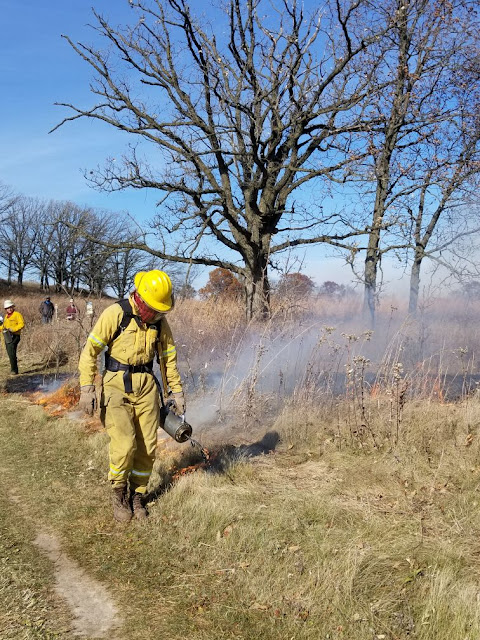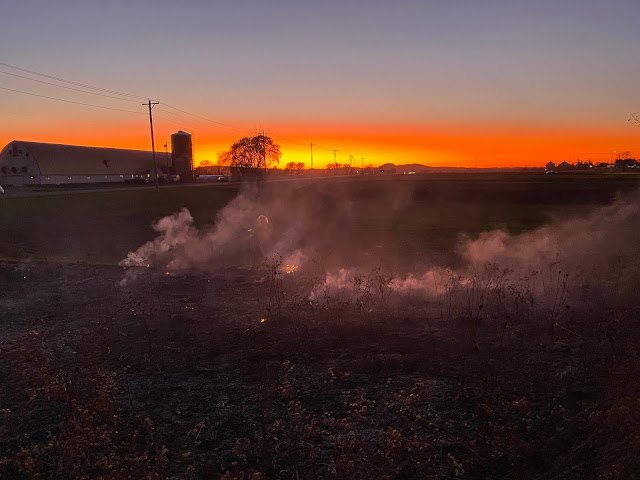NOTE: I originally wrote this piece for the Wild Ones Madison newsletter. However, I felt it was a good fit for Good Oak's blog as well.
This fall, we've had some good long dry spells which have allowed us to conduct several prescribed burns. Of course, this in the context of some truly terrifying wildfires out west this fall, particularly in Colorado and California. It definitely felt strange at times purposefully lighting up woodlands and prairies, on the same days as the headlines told of wildfires burning tens-of-thousands of acres in a day, or racing over 11,000-foot ridges on the continental divide. Yet in Wisconsin, these fall prescribed burns were mild, even compared to spring burns in the same setting, and had very different ecological impacts.
You may have read an article this fall about What Western States Can Learn from Native America Wildfire Management Strategies or Native Americans Reveal Their Secrets To Prevent Forest Fires And More, with the implication that this is new knowledge that is just seeing the light of day. But the truth is that ecologists have understood how valuable fire is to natural communities across the continent for over 70 years. Indeed, the understanding of role of fire in our ecosystems is nearly as old as the science of Ecology itself. Some of the first modern implementation of prescribed burns was done here at the University of Wisconsin Arboretum by early researchers including John Curtis and Aldo Leopold. The role of fire in our ecosystems is no recent revelation. Scientists and land managers have understood these lessons from Indigenous Americans for quite some time.
In our part of the world, from the Midwest to the East Coast, before Euro-American settlement, “wildfires” were primarily light by Indigenous Americans. These fires had many purposes. Fires would be lit to drive game during a hunt. They would be used to clear out vegetation around a village to make it easier to see approaching enemies, or as an offensive tactic in a battle. Clearing the landscape of vegetation by fire made travel much easier. Overall, it is clear that the Ho-Chuck here in south-central Wisconsin, and indigenous people across the region, understood the many ecological benefits of fire; how it would improve plant productivity for better wild food production, provide better forage for game, and keep encroaching woody vegetation at-bay.
Most of these fires were ignited in the fall, most likely as soon as vegetation was sufficiently cured to burn. And it wasn’t just prairies that burned. Wetlands would frequently burn, on a windy day fire could even carry in vegetation over open water. Woodlands burned too, in fact, the oak dominance of our local woodlands is a direct result of indigenous fire management. Our climate is very well suited for growing trees, it is only the frequent fires that created the tallgrass prairie, and that led to the dominance of fire-tolerant oaks and hickories (which coincidentally (or not?), are the most valuable trees for wildlife) in wooded areas. Prairies and savannas would likely burn nearly every year. There were however a few areas where water and topography conspired to 'protect' areas and reduce fire frequency. These include the near-shore areas of our Four Lakes and north facing slopes uphill from streams in the Driftless region. These are the only areas in the region where you would originally have seen less fire-tolerant tree such as red oak, sugar maple, elm and black cherry, among others. But even these forests patches would burn every few years; frequently enough to keep native shrubs and saplings in-check, while occasionally allowing a tree to get large enough to survive these very mild fires and reach the canopy.
 |
| Note How much partially-burned vegetation remains on the ground behind the fire. |
So what does this mean for prescribed burns today and what did I learn this fall?
- We need to burn our natural areas much, much more often. We should be burning roughly 1/3rd of the natural areas in our conservation parks, county and state parks, and state conservation areas each year. Unfortunately, right now, we’re only burning a tiny percentage of that on an annual basis, with severe ecological consequences.
- It can be hard to find good conditions for fall burns. The vegetation that burns during a prescribed burn, grasses, forbs and leaf litter, need to relatively free of water to ignite. First, we usually can’t burn until these plants go dormant, and/or until the leaves fall from canopy trees. That means the burn season doesn’t start until about Halloween each year. Second, with the shorter daylight length periods and increasingly cooler temperatures in fall, evaporation doesn’t happen as quickly as it does during the spring burn season. So often, you need 3-4 precipitation-free days to dry out fuel. Typically, by Thanksgiving the temperatures are too cold and the daylight length period is too short to allow vegetation to dry sufficiently for a burn.
- Even when the weather allows for good drying, other factors mean there is just more water in the vegetation in the fall. First, a surprising amount of water can be bound in the cellular tissues of plants. Over the winter, the frequent freeze and thaw causes tiny ice crystals start to perforate the cells of the plant. By spring, this dead vegetation can dry out more thoroughly than it can in the fall. Also, with shorter daylight periods in fall, and soils start to freeze overnight, soils tend to hold more moisture. Vegetation near the ground wicks up some of this moisture, making it more difficult to ignite. This is more of an issue for clay and loamy soils, and much less of an issue for better-drained sandy or gravelly soils.
- Fall burns are safer and easier to conduct. The devastating wildfires out west are the result of decades of fuel build-up, very dry fuels and very low humidity... and then, just a spark. But fuel moisture and humidity in the Midwest never get so extremely low. In spring, we sometimes get dry and windy days that produce extreme fire behavior and spot-fires. It takes good planning, experience, caution and skill to burn on those days, and some days we decide its just too risky. But in the fall you are unlikely to get very low-humidity days with very dry fuels, and so its a safer time of year for novice burners, or safer for more experience teams to burn more area more quickly.
- Fall burns often leave more refugia for wildlife as unburned areas often remain in the burn unit where animals can find shelter and food. Even a few inches of unburned duff at the ground layer, or tiny patches that don’t burn can provide refuge for overwintering insect eggs or adults. Sometimes as fire practitioners we want to see our whole burn unit 'black' when the fire is finished. But we need to get used to the idea that some unburned areas allow for wildlife refugia and healthy habitat heterogeneity.
- Fall burns favor wildflowers over grasses. We often see prairie plantings that are so dominated by warm-season prairie grasses (big bluestem, Indian grass, switchgrass, etc.) that hardly any pollinator-feeding wildflowers remain. This is often because the initial seed mix was too heavy on the grasses, and little interseeding has been done since to improve forb diversity and abundance. However, the issue is exacerbated since most prescribed burns are conducted in mid-to-late-spring, which strongly favors these warm-season grasses. Fall burns give the wildflowers, sedges and native cool-season grasses a head-start on growth in the spring before the tall grasses emerge around mid-May.
- Fall burns are better for adding more plant diversity by seeding. Again, one can imagine that in-situ seeds will be better able to survive in a few inches of unburned duff on the ground than they would in a hotter spring burn when the fire burns all the way down to bare mineral soil. But clearing the soil surface of most vegetation gives any seeds you spread within the burn unit good contact with the soil and access to sunlight so they are able to germinate in the spring.
Generally, fall burns have different effects than the more widely practiced spring burns and are arguably more beneficial, especially for managing remnant sites or when trying to increase plant diversity and insect abundance. So in contrast to current practices, I would recommend land owners and land managers try to do as much burning as they can in the fall. If conditions don’t allow you to conduct the burn in the fall, your fire breaks and burn plans will already be set and you’ll be ready to conduct the burn first thing in the spring. By planning to take advantage of burn opportunities in the fall, we can have more time to burn every year, and see the ecological benefits of burning across more of our landscape.





